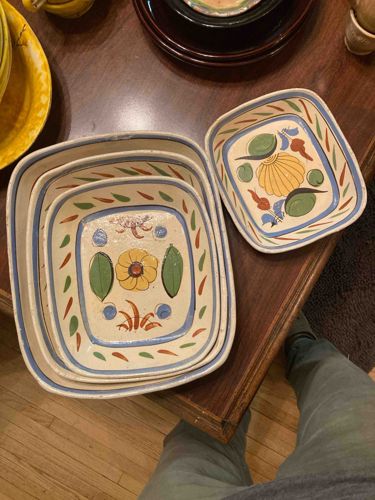
Set of Four Mexican Talavera Nesting Trays
This is a set of four nesting trays, handcrafted from ceramic or earthenware, most likely in the Talavera style from Mexico, as suggested by the context. The trays are rectangular with gently rounded corners, giving them a softened square appearance. They are designed to nest within each other for compact storage, with the smallest tray being presented separately to the right of the nested three. The primary color of the glaze is an antique white or very light cream, providing a canvas for the hand-painted decorations. Each tray features a distinct, colorful motif in the center, encircled by a blue band. The largest three trays share a common floral theme, with a central yellow flower with a red-brown center, flanked by two elongated green leaves and small blue circular accents. The outermost border of these larger trays is decorated with repeating patterns of green leaf-like shapes and rust-brown dashes, all framed by a thin blue line along the rim. The smallest tray, however, features a different central design: a prominent yellow scallop shell, surrounded by green oval elements and various abstract red and blue flourishes. The borders of the smallest tray follow a similar pattern to the larger ones, with green and red accents within a blue rim. The painting style is naive and folk-art inspired, indicative of traditional Mexican pottery. The glazes appear to be somewhat thick and uneven in areas, suggesting hand-application and contributing to their rustic charm. Visible condition issues include minor wear consistent with age and use, such as slight imperfections in the glaze, possible small chips or crazing that are not clearly discernible from the provided images but are typical for this type of pottery. The edges of the trays show some inconsistencies in form and finish, further emphasizing their handmade origin. There are no clear maker's marks or signatures visible from the top-down view. Based on the style and typical production, these trays likely date to the mid-20th century, though without specific marks, it is difficult to determine a precise age. The overall craftsmanship suggests a utilitarian yet decorative item, intended for serving or display, characterized by its vibrant color palette and distinctive hand-painted designs.
AI-Generated Appraisal Disclaimer
Estimated Value
$75-150
Basic Information
Category
Ceramic Tableware and Decor
Appraised On
November 20, 2025
Estimated Value
$75-150
Additional Details Provided By Owner
User Provided Information
Set of four rectangular nesting trays made in Mexico
Item Description
This is a set of four nesting trays, handcrafted from ceramic or earthenware, most likely in the Talavera style from Mexico, as suggested by the context. The trays are rectangular with gently rounded corners, giving them a softened square appearance. They are designed to nest within each other for compact storage, with the smallest tray being presented separately to the right of the nested three. The primary color of the glaze is an antique white or very light cream, providing a canvas for the hand-painted decorations. Each tray features a distinct, colorful motif in the center, encircled by a blue band. The largest three trays share a common floral theme, with a central yellow flower with a red-brown center, flanked by two elongated green leaves and small blue circular accents. The outermost border of these larger trays is decorated with repeating patterns of green leaf-like shapes and rust-brown dashes, all framed by a thin blue line along the rim. The smallest tray, however, features a different central design: a prominent yellow scallop shell, surrounded by green oval elements and various abstract red and blue flourishes. The borders of the smallest tray follow a similar pattern to the larger ones, with green and red accents within a blue rim. The painting style is naive and folk-art inspired, indicative of traditional Mexican pottery. The glazes appear to be somewhat thick and uneven in areas, suggesting hand-application and contributing to their rustic charm. Visible condition issues include minor wear consistent with age and use, such as slight imperfections in the glaze, possible small chips or crazing that are not clearly discernible from the provided images but are typical for this type of pottery. The edges of the trays show some inconsistencies in form and finish, further emphasizing their handmade origin. There are no clear maker's marks or signatures visible from the top-down view. Based on the style and typical production, these trays likely date to the mid-20th century, though without specific marks, it is difficult to determine a precise age. The overall craftsmanship suggests a utilitarian yet decorative item, intended for serving or display, characterized by its vibrant color palette and distinctive hand-painted designs.
Get Your Items Appraised
Instant estimates of your treasures with AI-powered instant appraisals